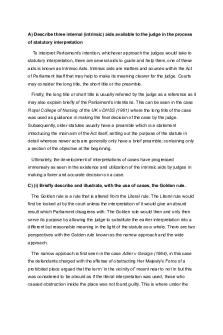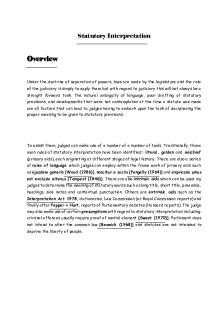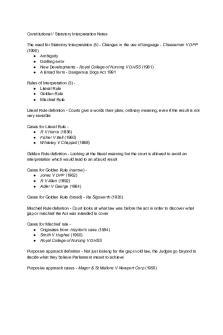Guide to statutory interpretation PDF

| Title | Guide to statutory interpretation |
|---|---|
| Author | Gabrielle Colin |
| Course | Foundations of Australian Law |
| Institution | Australian National University |
| Pages | 3 |
| File Size | 116.1 KB |
| File Type | |
| Total Downloads | 18 |
| Total Views | 142 |
Summary
Download Guide to statutory interpretation PDF
Description
Guide to statutory interpretation 1. Commencement Does the Act provide a commencement date? If the Act does not specifically state a commencement date, rely on S3(2) of the AIA “An Act (other than an Act to alter the Constitution) commences on the 28th day after the day on which that Act receives the Royal Assent.” Remember that an Act does not operate retrospectively this is a strong presumption and is illustrated in Rodway v The Queen “The rule at common law is that a statute ought not be given a retrospective operation where to do so would affect an existing right or obligation” However, this presumption is limited if the statute affects procedure. This is again outlined in Rodway v The Queen “Where procedure alone is involved, a statute will invariably operate prospectively”
2. Break up the provision List each element needed to satisfy a section of the Act
3. Non-contentious issues If there are non-contentious issues, deal with them rapidly Refer to definitions provided in the Act and in the AIA (S2B-d)
4. Contentious issues – the contextual approach Under CIC Insurance Ltd v Bansktown Football Club Ltd: “The modern approach to statutory interpretation … insists that the context be considered in the first instance” Start with the ordinary and natural meaning of the words. This relies on definitions. Remember to note whether a definition is open or closed and how this impacts the meaning of the provision. Do so in the following order: Definition section of the Act Definition section of the AIA Judicial interpretation Re-enactment constitutes approval of previous judicial interpretation weaker presumption Its limitations are outlines in Faherty v Girgis: “Mere amendment of a statute not involving any re-enactment of the words in question could seldom if ever constitute approval of an interpretation of those words” “At most, the principle affords a presumption of no great weight concerning the meaning of the words and cannot be relied upon to perpetuate an erroneous construction”
Dictionary definition In State Chamber of Commerce and Industry v Commonwealth, five Justices of the High Court consulted the Macquarie Dictionary Apply the Maxims of interpretation if need be -
-
-
Noscitur a sociis: the meaning of a word is known from the words that accompany it o R v Ann Harris: the prisoner (who had bitten another inmate) was found not guilty because the act referred to ‘stab, cut or wound’. Patterson J directed the Jury that it was the intention of the legislature, according to the words of the Act, that wounding should be inflicted with an instrument, and not by the hand and teeth Ejusdem generis: if words of particular meaning are followed by general words, the general words are limited to the same kind as the particular words. o Most Australian Wills Acts provide that a will may be revoked by ‘burning, tearing or otherwise destroying the will’. If interpreted by ejusdem generis, writing ‘cancelled’ on the will won’t be revoked Expressio unious exclusion alterius: ‘the express mention of one thing is the exclusion of another’
Every time a maxim of interpretation is used, integrate this quote: “Valuable servant but a dangerous master to follow” (Colquhoun v Brooks)
5. Contentious issues – the purposive approach **If you came up with a good, strong meaning for the provision under the contextual approach, then this section can be quite short ** Rely on S15AA of the AIA: “In interpreting a provision of an Act, the interpretation that would best achieve that purpose or object of the Act is to be preferred to each other interpretation” Look at the statute as a whole, including any express statements Remember that when using the purposive method for interpretation, it requires the court to construe the Act, not re-write it. This is established in Mills v Meeking -
S15AA allows a court to consider the purposes of an Act in determining whether there is more than one possible construction. References to the purposes may reveal that the draftsman of the Act has overlooked something which may need to be repaired. However, if the literal meaning of a provision is to be modified by reference to the purpose of the Act, the modification must be identifiable as something necessary to effectuate the purpose of the Act.
6. Extrinsic materials (not under a new heading, technically still under the purposive approach) Only go to extrinsic materials if the meaning of the provision is still unclear after both the contextual and purposive approach. Under CIC Insurance Ltd v Bankstown Football Club Ltd :
“At common law, apart from any reliance upon s15AB of the Acts Interpretation Act 1901, the court may be regard to reports of law reform bodies to ascertain the mischief which a state is intended to cure.” Remember that there are conditions that need to be satisfied before extrinsic materials can be used. These are also outlined in Mills v Meeking “The modern approach to statutory interpretation (a) insists that the context be considered in the first instance, not merely at some later stage when ambiguity might be thought to arise and (b) uses ‘context’ in its widest sense to include such things as the existing state of the law and the mischief … the statute was intended to remedy” This must be accompanied by SM v The Queen: “Any provisions must be read in context, and against the background of the Act as whole” Extrinsic material may be used under S15AB of the Acts Interpretation Act 1901 (Cth) Under S15AB of the AIA, extrinsic materials may be used to confirm the ordinary meaning of a provision in cases of ambiguity or doubt or where the ordinary meaning leads to an absurd result. This was reinforced in Re Australian Federation of Construction Contractors; Ex parte Billing: “Section 15AB of the Acts Interpretation Act 1901 … does not permit recourse to [extrinsic materials] for the purpose of departing from the ordinary meaning of the text unless either the meaning of the provision to be construed is ambiguous or obscure or in its ordinary meaning leads to a result that is manifestly absurd or unreasonable” The application of S15AB is exemplified in Re Shingles and Director General of Social Security (1984) “The manifest absurdity and unreasonableness of the ordinary meaning of those provisions is apparent when one considers the the effect of a strict literal interpretation” Because of the absurd provision of the Act which would not provide for the welfare of disabled children, extrinsic materials were permitted in accordance with S15AB 7. Presumptions Don’t just wait until the end to use them – if you can, try to integrate them into your answer For example, the presumption that Parliament does not interfere with the fundamental common law rights. This is a very strong presumption and is highlighted in Coco v The Queen: The appellant was convicted of a crime under the Crimes Act 1914 (Cth), but the evidence procured was illegal (obtained by trespassing). This infringed on the common law right against trespass and so the appeal was successful.
8. Conclusion You should be making a mini-conclusion of what your thoughts/findings are in each section If you get to the end of your term and the meanings is still unclear/ambiguous, you need to go with the interpretation that supports the purpose, without rewriting the ordinary meaning Don’t forget to relate it back to the question...
Similar Free PDFs

Statutory Interpretation
- 6 Pages

Statutory Interpretation
- 6 Pages

Statutory Interpretation
- 3 Pages

Statutory Interpretation
- 5 Pages

Statutory Interpretation
- 11 Pages

Statutory Interpretation
- 6 Pages

Statutory interpretation notes
- 2 Pages

Statutory Interpretation 70102
- 5 Pages

Statutory Interpretation in Malaysia
- 12 Pages

Statutory Interpretation Notes
- 9 Pages

Statutory Interpretation Notes
- 4 Pages
Popular Institutions
- Tinajero National High School - Annex
- Politeknik Caltex Riau
- Yokohama City University
- SGT University
- University of Al-Qadisiyah
- Divine Word College of Vigan
- Techniek College Rotterdam
- Universidade de Santiago
- Universiti Teknologi MARA Cawangan Johor Kampus Pasir Gudang
- Poltekkes Kemenkes Yogyakarta
- Baguio City National High School
- Colegio san marcos
- preparatoria uno
- Centro de Bachillerato Tecnológico Industrial y de Servicios No. 107
- Dalian Maritime University
- Quang Trung Secondary School
- Colegio Tecnológico en Informática
- Corporación Regional de Educación Superior
- Grupo CEDVA
- Dar Al Uloom University
- Centro de Estudios Preuniversitarios de la Universidad Nacional de Ingeniería
- 上智大学
- Aakash International School, Nuna Majara
- San Felipe Neri Catholic School
- Kang Chiao International School - New Taipei City
- Misamis Occidental National High School
- Institución Educativa Escuela Normal Juan Ladrilleros
- Kolehiyo ng Pantukan
- Batanes State College
- Instituto Continental
- Sekolah Menengah Kejuruan Kesehatan Kaltara (Tarakan)
- Colegio de La Inmaculada Concepcion - Cebu




